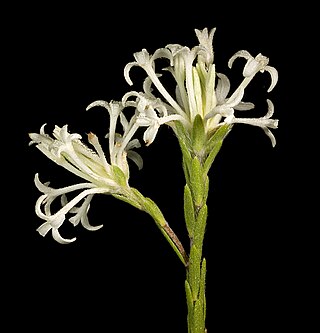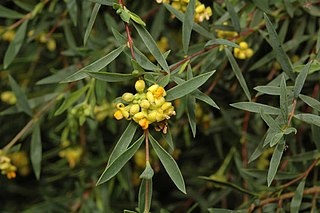
Pimelea microcephala, commonly known as mallee rice-flower or shrubby rice-flower is a species of flowering plant in the family Thymelaeaceae and is endemic to mainland Australia. It is an erect shrub with compact heads of male or female, white to yellow or greenish flowers on separate plants, the heads surrounded by 2 or 4 leaf-like involucral bracts.

Pimelea flava is a species of flowering plant in the family Thymelaeaceae and is endemic to south-eastern Australia. It is a shrub with narrowly elliptic to egg-shaped leaves arranged in opposite pairs, and compact clusters of 9 or more flowers with 2 or 4 elliptic to circular involucral bracts at the base. The flowers and bracts are white or yellow, depending on subspecies.

Pimelea octophylla, commonly known as woolly riceflower or downy riceflower, is a species of flowering plant in the family Thymelaeaceae and is endemic to south-eastern continental Australia. It is an erect shrub with densely hairy young stems, narrowly elliptic leaves and heads of 22 to 45 densely hairy, cream-coloured to pale yellow flowers surrounded by 6 to 12 leaf-like involucral bracts.

Pimelea alpina, the alpine rice-flower, is a species of flowering plant in the family Thymelaeaceae and is endemic to south-eastern continental Australia. It is an erect, prostrate or spreading shrub or undershrub with narrowly elliptic leaves crowded at the ends of branches and heads of pinkish red or white flowers.

Pimelea hewardiana, commonly known as forked rice-flower, is a species of flowering plant in the family Thymelaeaceae and is endemic to south-eastern continental Australia. It is a shrub with narrowly elliptic leaves and head-like clusters of 7 to 34 unisexual yellow flowers.

Pimelea longiflora is a species of flowering plant in the family Thymelaeaceae and is endemic to the southwest of Western Australia. It is an erect, spindly shrub with linear to narrowly elliptic leaves and erect clusters of white to cream-coloured flowers, surrounded by 4 to 6 green, egg-shaped involucral bracts.

Pimelea neoanglica, commonly known as poison pimelea or scanty riceflower, is a species of flowering plant in the family Thymelaeaceae and is endemic to inland areas of eastern Australia. It is an erect, dioecious shrub with narrowly elliptic leaves and heads of greenish-yellow flowers.
Pimelea clavata is a species of flowering plant in the family Thymelaeaceae and is endemic to near-coastal areas and offshore islands of southern Western Australia. It is an erect shrub with narrowly elliptic to more or less linear leaves arranged in opposite pairs, and head-like clusters of white to pale yellow, tube-shaped flowers surrounded by leaf-like involucral bracts.
Pimelea eyrei is a species of flowering plant in the family Thymelaeaceae and is endemic to the southwest of Western Australia. It is an erect shrub with hairy, narrowly elliptic leaves and clusters of densely hairy, white or cream-coloured flowers.
Pimelea forrestiana is a species of flowering plant in the family Thymelaeaceae and is endemic to Western Australia. It is a shrub with linear to narrowly elliptic leaves arranged in opposite pairs, and head-like clusters of yellow, tube-shaped flowers.
Pimelea gilgiana is a species of flowering plant in the family Thymelaeaceae and is endemic to near-coastal areas of north-western Western Australia. It is a shrub with narrowly egg-shaped leaves and head-like clusters of white or pinkish, dioecious flowers.

Pimelea haematostachya, commonly known as pimelea poppy, is a species of flowering plant in the family Thymelaeaceae and is endemic to Queensland. It is a perennial herb with narrowly egg-shaped or narrowly elliptic leaves and heads of red flowers.
Pimelea lanata is a species of flowering plant in the family Thymelaeaceae and is endemic to the southwest of Western Australia. It is a shrub with narrowly elliptic leaves and erect clusters of white to deep pink flowers surrounded by 4, mostly green, involucral bracts.

Pimelea leucantha is a species of flowering plant in the family Thymelaeaceae and is endemic to near-coastal areas in the west of Western Australia. It is a shrub with linear to narrowly egg-shaped or narrowly elliptic leaves and clusters of white to pale yellow flowers surrounded by 4 or 6 egg-shaped involucral bracts.
Pimelea macrostegia is a species of flowering plant in the family Thymelaeaceae and is endemic to Kangaroo Island in South Australia. It is a shrub with glabrous, narrowly elliptic leaves and clusters of pale yellow flowers surrounded by 4 or 6 egg-shaped, pale green involucral bracts.
Pimelea micrantha, commonly known as silky rice-flower is a species of flowering plant in the family Thymelaeaceae and is endemic to southern Australia. It is a much-branched undershrub with narrowly elliptic to lance-shaped leaves and compact clusters or heads of densely hairy, creamy white flowers.
Pimelea milliganii, commonly known as silver riceflower or Milligan's rice flower, is a species of flowering plant in the family Thymelaeaceae and is endemic to a restricted part of Tasmania. It is a low, much-branched, densely hairy shrub with more or less elliptic leaves and compact clusters of white to pinkish flowers usually surrounded by two leaf-like involucral bracts.
Pimelea neokyrea is a species of flowering plant in the family Thymelaeaceae and is endemic to the southwest of Western Australia. It is a low, spreading shrub with narrowly egg-shaped to narrowly ellipic leaves and erect clusters of white or pale yellow flowers surrounded by egg-shaped involucral bracts. It was previously included in Pimelea avonensis.
Pimelea pelinos is a species of flowering plant in the family Thymelaeaceae and is endemic to a small area in the southwest of Western Australia. It is an erect, straggling shrub with narrowly egg-shaped leaves, the narrower end towards the base, and erect clusters of cream-coloured, unisexual flowers surrounded by 2 or 4 egg-shaped, leaf-like involucral bracts.
Pimelea penicillaris, commonly known as sandhill riceflower, is a species of flowering plant in the family Thymelaeaceae and is endemic to Central Australia. It is an erect, dioecious shrub with densely hairy young stems, densely hairy, pale silvery green, elliptic leaves, and compact heads of white to yellow or pink flowers surrounded by 6 to 12 silky-hairy, silvery or brownish involucral bracts.








